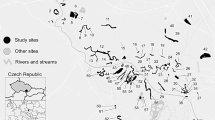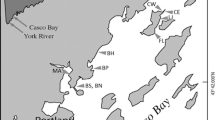Abstract
Molluscs were collected monthly for a year from two low salinity (0–9‰) intertidal marshes dominated by the macrophytesJuncus roemerianus orSpartina cynosuroides in St. Louis Bay, Mississippi. TheJuncus marsh had lower soil organic matter, higher pH and was more frequently inundated than theSpartina marsh. Eight species of gastropods were abundant and dominated in the higherSpartina marsh, while three bivalve species were dominant in theJuncus marsh. Of the common species,Succinea ovalis, Vertigo ovata andDeroceras laeve are gastropods of terrestrial origins;Geukensia demissa granosissima (bivalve) andMelampus bidentatus (gastropod) are euryhaline estuarine species and the remaining gastropods (Detracia floridana, Littoridinops palustris, Onobops jacksoni) and bivalves (Polymesoda caroliniana, Cyrenoida floridana) are brackish species. Most species were capable of continuous recruitment (based on size class analysis), but exhibited peak activity in particular seasons. Bivalve abundance correlated to temperature, and gastropod abundance was negatively correlated to soil pH. These correlations reflect the influence of flooding regime at the two sites. Biomass was greater in theJuncus marsh because of the increased presence of the large-bodiedPolymesoda. Polymesoda represented >90% and >50% of the total biomass in theJuncus andSpartina (except summer) marshes respectively but always <-5% of the individuals collected. Gastropod biomass was the same in both marshes. Species diversity (H′) was greater inSpartina except for summer months. TheJuncus marsh always exhibited greater species richness. Evenness (J′) determined seasonal changes in diversity (H′). Similarity values (Cz) were always quite low, with highest values in spring In contrast to faunal studies from Gulf and East Coast salt marshes, we found 1) fewer species, 2) communities comprised of unique species combinations, 3) greatest mean densities in summer, and 4) potentially less productivity by the molluscs of our sites. These mollusc communities exhibit structural characteristics that emphasize the unique ecotonal nature of the oligohaline marshes within which they are found.
Similar content being viewed by others
Literature Cited
Bell, S. S. 1979. Short- and long-term variation in a high marsh meiofaunal community.Estuarine Coastal Mar. Sci. 9: 331–350.
Bell, S. S. 1980. Meiofauna-macrofauna interactions in a high salt marsh habitat.Ecol. Monogr. 50:487–505.
Bell, S. S. 1982. On the population biology and meiofaunal characteristics ofManayunkia aestuarina (Polychaeta: Sabellidae: Fabricinae) from a South Carolina salt marsh.Estuarine Coastal Shelf Sci. 14:215–221.
Bertness, M. D., andE. Grosholz. 1985. Population dynamics of the ribbed mussel,Geukensia demissa: The costs and benefits of an aggregated distribution.Oecologia (Berlin) 67: 192–204.
Bloom, S. A. 1981. Similarity indices in community studies: Potential pitfalls.Mar. Ecol. Prog. Ser. 5(2):125–128.
Bouyoucos, G. J. 1928. Making mechanical analyses of soils in fifteen minutes.Soil Sci. 25:473–480.
Cammen, L. M. 1976. Abundance and production of macroin-vertebrates from natural and artificially established salt marshes in North Carolina.Am. Midl. Nat., 96:487–493.
Cammen, L. M. 1979. The macro-infauna of a North Carolina salt marsh.Am. Midl. Nat. 102:244–253.
Cammen, L. M., U. Blum, E. D. Seneca, andL. M. Stroud. 1982. Energy flow in a North Carolina salt marsh: A synthesis of experimental and published data.ASB Bull. 29:111–134.
Carriker, M. R. 1967. Ecology of estuarine benthic invertebrates: A perspective, p. 442–487.In G. H. Lauff (ed.), Estuaries. American Association for the Advancement of Science, Washington, D.C.
Daiber, F. C. 1982. Animals of the Tidal Marsh. Van Nostrand Reinhold Co. New York. 422 p.
Day, J. H., J. G. Field, andM. P. Montgomery. 1971. The use of numerical methods to determine the distribution of the benthic fauna across the continental shelf of North Carolina.J. Anim. Ecol. 40:93–125.
Day, J. W. Jr.,W. G. Smith, P. R. Wagner, andW. C. Stowe. 1973. Community structure and carbon budget of a salt marsh and shallow bay estuarine system in Louisiana. Center for Wetland Resources Publ. LSU-SG-72-04. Louisiana State University, Baton Rouge. 79 p.
DeLaune, R. D., W. H. Patrick Jr., andJ. M. Brannon. 1976. Nutrient transformations in Louisiana salt marsh soils. Center for Wetland Resources. Sea Grant Publication No. LSU-T-76-009. Louisiana State University, Baton Rouge.
Duobinis-Gray, E. M., andC. T. Hackney. 1982. Seasonal and spatial distribution of the carolina marsh clamPolymesoda caroliniana (Bosc) in a Mississippi tidal marsh.Estuaries 5:102–109.
Eleuterius, L. N. 1973. The marshes of Mississippi, p. 147–190.In J. Y. Christmas (ed.), Cooperative Gulf of Mexico Estuarine Inventory and Study—Mississippi. Phase IV: Section I. Gulf Coast Research Laboratory. Ocean Springs, Mississippi.
Eleuterius, L. N. 1976. The distribution ofJuncus roemerianus in the salt marshes of North America.Chesapeake Sci. 17:289–292.
Elliott, J. M. 1977. Some Methods for the Statistical Analysis of Samples of Benthic Invertebrates. Freshwater Biological Association Scientific Publication #25. 160 p.
Fell, P. E., N. C. Olmstead, E. Carlson, W. Jacob, D. Hitchcock, andG. Shubert. 1982. Distribution and abundance of macroinvertebrates on certain Connecticut tidal marshes, with emphasis on dominant molluscs.Estuaries 5: 234–239.
Gerlach, S. A. 1971. On the importance of marine meiofauna for benthos communitiesOecologia (Berlin) 6:176–190.
Hackney, C. T. 1985. A note on the effects of abnormally low temperture on the carolina marsh clam.Estuaries 8:394–395.
Hackney, C. T., andT. D. Bishop. 1981. A note on the relocation of marsh debris during a storm surge.Estuarine Coastal Mar. Sci. 12:621–624.
Hackney, C. T., andA. A. de la Cruz. 1978. Changes in interstitial water salinity of a Mississippi tidal marsh.Estuaries 1:185–188.
Hackney, C. T., andA. A. de la Cruz. 1980.In situ decomposition of roots and rhizomes of two tidal marsh plants.Ecology 61:226–231.
Hackney, C. T., andA. A. de la Cruz. 1981. Some notes on the macrofauna of an oligohaline tidal creek in Mississippi.Bull. Mar. Sci. 31:658–661.
Hackney, C. T., andA. A. de la Cruz. 1982. The structure and function of brackish marshes in the north central Gulf of Mexico: A ten year case study, p. 89–109.In B. Gopal, R. E. Turner, R. G. Wetzel, and D. F. Whigham, (eds.). Wetlands: Ecology and Management. Jaipur, India. International Scientific Publications.
Heard, R. W. 1982. Guide to Common Tidal Marsh Invertebrates of the Northeast Gulf of Mexico. Mississippi-Alabama Sea Grant Consortium, MASGC-79-004. 82 p.
Howmiller, R. P. 1972. Effects of preservatives on weights of some common macrobenthic invertebrates.Trans. Am. Fish. Soc. 101:743–746.
Humphrey, W. D. 1979. Diversity, distribution and relative abundance of benthic fauna in a Mississippi tidal marsh. Ph.D. Dissertation. Mississippi State University, Mississippi State. 93 p.
Kat, P. W. 1982. Reproduction in a peripheral population ofCyrenoida floridana (Bivalvia: Cyrenoididae).Malacologia 23: 47–54.
Keefe C. W. 1972. Marsh production: A summary of the literature.Contrib. Mar. Sci. Univ. Texas 16:163–182.
Kneib, R. T. 1984. Patterns of invertebrate distribution and abundance in the intertidal salt marsh: Causes and questions.Estuaries 7:392–412.
Kneib, R. T., andA. E. Stiven. 1982. Benthic invertebrate responses to size and density manipulations of the common mummichog,Fundulus heteroclitus, in an intertidal salt marsh.Ecology 63:1518–1532.
LaSalle, M. W., andA. A. de la Cruz. 1985. Seasonal abundance and diversity of spiders in two intertidal marsh plant communities.Estuaries 8:381–393.
Long, S. P., andC. F. Mason. 1983. Salt Marsh Ecology. Blackie and Son Ltd., London. 160 p.
MacDonald, K. B. 1969. Quantitative studies of salt marsh mollusc faunas from the North American Pacific coast.Ecol. Monogr. 39:33–60.
Mendelssohn, I. A., andK. L. Marcellus 1976. Angiosperm production of three Virginia marshes in various salinity and soil nutrient regimes.Chesapeake Sci. 17:15–23.
Montague, C. L., S. M. Bunker, E. B. Haines, M. L. Pace, andR. L. Wetzel. 1981. Aquatic macroconsumers, p. 69–86.In L. R. Pomeroy and R. G. Wiegert (eds.). The Ecology of a Salt Marsh. Ecological Studies #38. Springer-Verlag, New York.
Odum, E. P. 1961. The role of tidal marshes in estuarine production.N. Y. State Conserv. 15:12–15.
Parker, N. H. 1976. The distribution, growth and life history ofMelampus bidentatus (Gastropoda: Pulmonata) in the Delaware Bay region. M.S. Thesis. University of Delaware. 65 p.
Pielou E. C. 1975. Ecological Diversity. John C. Wiley and Sons, New York. 165 p.
Sanders, H. L. 1956. Oceanography of Long Island Sound. X. The biology of marine bottom communities.Bull. Bingham Oceanogr. Collect. Yale Univ. 15:345–414.
Stout, J. P. 1984. The Ecology of Irregularly Flooded Salt Marshes of the Northeastern Gulf of Mexico: A Community Profile. U.S. Fish Wildl. Serv. Biol. Rep. 85(7.1). 98 p.
Subrahmanyam, C. B., andC. L. Coultas. 1980. Studies on the animal communities in two north Florida salt marshes. Part III. Seasonal fluctuations of fish and macroinvertebrates.Bull. Mar. Sci. 30:790–818.
Subrahmanyam, C. B., W. L. Kruczynki, andS. H. Drake. 1976. Studies on the animal communities in two north Florida salt marshes. Part II. Macroinvertebrate communities.Bull. Mar. Sci. 26:172–195.
Teal, J. M. 1962. Energy flow in the salt marsh ecosystem of Georgia.Ecology 43:614–624.
Weiss, T. E., D. A. White, andL. B. Thien. 1979. Seasonal dynamics of salt marsh plant associations in Louisiana.Contrib. Mar. Sci. 22:41–52.
Wiegert, R. G., andF. C. Evans. 1967. Investigations of secondary productivity in grasslands, p. 499–518.In: K. Petrusewicz (ed.), Secondary Productivity of Terrestrial Ecosystems. Krakow: Polish Academy of Science.
Zar, J. H. 1974. Biostatistical Analysis. Prentice-Hall, Englewood Cliffs. 620 p.
Author information
Authors and Affiliations
Rights and permissions
About this article
Cite this article
Bishop, T.D., Hackney, C.T. A comparative study of the mollusc communities of two oligohaline intertidal marshes: Spatial and temporal distribution of abundance and biomass. Estuaries 10, 141–152 (1987). https://doi.org/10.2307/1352179
Received:
Accepted:
Issue Date:
DOI: https://doi.org/10.2307/1352179




